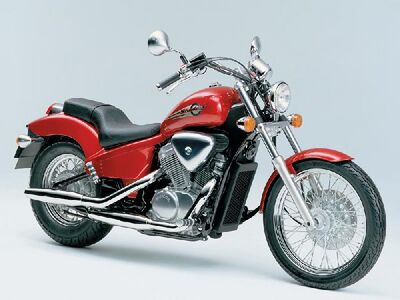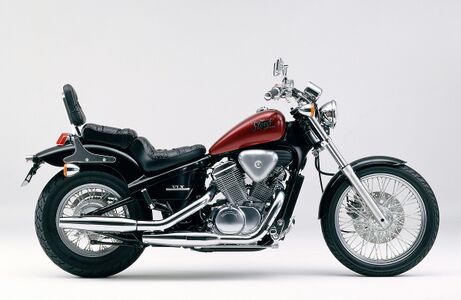Honda Steed 400
The cruiser model Honda Steed 400 appears on the Japanese market in 1988 in parallel with the older version Honda Steed 600. In the early years of production (until 1991), the model was in extremely low demand and there were even rumors that Honda was planning to complete production of the motorcycle. By 1993, however, Japan was experiencing another boom in American-style motorcycles, and the Steed 400 quickly became a bestseller - in 10 years of production, the total number of Steed 400 and 600 sold reached 80,000 units.
Lineup:
Main competitors:
- Suzuki Intruder 400 / Suzuki LS400 Savage
- Kawasaki VN 400 Vulcan / Kawasaki EN400 Vulcan
- Yamaha XV400 Virago / Yamaha XVS 400 Drag Star
Why did both versions exist at the same time? The fact is that in Japan, driving licenses for motor vehicles have a different level, depending on the driving experience. Thus, the Steed 400 could be used by any aspiring driver who had recently graduated from motorcycle school, while the Honda Steed 600 required a more advanced license.
The model was based on a 2-cylinder V-shaped liquid-cooled engine with a volume of 398 cm³, producing 30-31 hp. power and 32-33 Nm of torque. This motor was also installed on Honda XL400V Transalp, Honda VRX 400, Honda Bros 400 and Honda Shadow 400.
Of the features of the Steed 400, it should be noted the classic steel duplex frame, front disc and rear drum brakes, simple suspensions in the form of a conventional telescopic fork (VLS - springer) and a rear mono-shock absorber, a fuel tank of 9-11 liters (depending on the year and version), 5-speed gearbox and curb weight from 208 kg.
At first, there was only one modification of the Honda Steed 400 on the market (in addition, it was possible to choose only a steering wheel - a curved or straight drag bar), which received the abbreviation `` VLX (transcript: V-Twin, Lowered, eXtended rake) - this is designation of the standard version of the motorcycle.
In 1995, the model line was replenished with 2 modifications at once - VCL (transcript: V-Twin, Custom Limited) and VSE (transcript: V-Twin, Special Edition). The VCL is a budget variant of the standard VLX, featuring no passenger backrest, a drag bar in stock and a simpler saddle. This version was 30,000 yen cheaper than the VLX. The VSE modification received a cast rear wheel in the style of Honda Magna and a curved steering wheel in stock. Both versions existed until 1996, after which they were no longer offered.
In 1998, a new modification was added to the Steed 400 line - VLS (transcript: V-Twin, Lowered, Springer front end). It features unique styling with a springer instead of a classic fork, a 21 'front wheel, reduced fuel tank, ergonomics and dimensions. This version existed only during 1998.
2001 was the last year of production of the Honda Steed 400, which was slightly updated (added an exhaust afterburning system for new environmental standards and other minor innovations) and finally rolled off the assembly line. In 1997, a new model was proposed as the successor to the Steed 400 - Honda Shadow 400.
Photos
Specifications
Specifications Honda Steed 400:
| Model | Honda Steed 400 |
|---|---|
| Motorcycle type | cruiser |
| Release year | 1988-2001 |
| Frame | steel tubular |
| Engine type | 2-cylinder, 4-stroke, V-shaped |
| Working volume | 398 cm³ |
| Bore / stroke | 64.0 x 62.0 mm |
| Compression ratio | 10.0: 1 - Steed 400, 1988-1995
9.8: 1 - Steed 400, from December 1995 to 2001 |
| Cooling | liquid |
| Number of valves per cylinder | SOHC, 3 valves per cylinder |
| Fuel supply system | carburetor, 2x Keihin 34 mm (VDD0) |
| Ignition type | transistor |
| Maximum power | 30.0 h.p. (22.0 kW) @ 7500 rpm - Steed 400 (1988-1994)
31.0 h.p. (22.8 kW) @ 7500 rpm - Steed 400 (1995-2001) |
| Maximum torque | 32.0 Nm (3.3 kg * m) @ 5500 rpm - Steed 400 (1988-1994)
33.0 Nm (3.4 kg * m) / 5500 rpm - Steed 400 (1995-2000) 33.0 Nm (3.4 kg * m) / 6000 rpm - Steed 400 (2001) |
| Gearbox | 5-speed |
| Drive type | chain |
| Front tire size | 100 / 90-19 57S
90 / 90-21 54S - VLS |
| Rear tire size | 170 / 80-15 77S |
| Front brakes | 1 disc, 296 mm, 2-piston caliper |
| Rear brakes | drum |
| Front suspension | telescopic fork
Springer - VLS |
| Rear suspension | linkage with monoshock |
| Motorcycle length | 2310 mm
2335 mm - VLS |
| Motorcycle width | 760 mm
705mm - VLX with drag wheel, VCL 865 mm - VSE 765 mm - VLS 890mm - VLX (2001) |
| Motorcycle height | 1130 mm
1105mm - VLX with drag wheel, VCL 1120 mm - VSE, VLX (2001) 1115 mm - VLX (1998-2000), VLS |
| Wheelbase | 1600 mm
1620 mm - VLS |
| Saddle height | 680 mm
670 mm - VLX (1998-2001) 650 mm - VLSD |
| Minimum ground clearance | 140 mm
130 mm - VLX (1998-2001), VLS |
| Acceleration to 100 km / h | 11.1 sec |
| Maximum speed | 130 km / h |
| Fuel tank capacity | 9.0 L - Steed 400 (1988-1992)
11.0 L - Steed 400 (1993-2001) 9.7 L - VLS |
| Motorcycle weight (dry) | 196 kg - Steed 400 (1988-1989)
199 kg - Steed 400 VLX (1990-1992) 201 kg - Steed 400 VLX (1993) 204 kg - Steed 400 VLX (1994-1997), VCL 203 kg - VSE, VLX (1998-2001) 211 kg - VLS |
| Motorcycle weight (curb) | 208 kg - Steed 400 (1988-1989)
211 kg - Steed 400 VLX (1990-1992) 214 kg - Steed 400 VLX (1993) 217 kg - Steed 400 VLX (1994-1997), VCL 216 kg - VSE 215 kg - VLX (1998-2001) 223 kg - VLS |
Fuel consumption
The officially declared fuel consumption of the Honda Steed 400 is 2.74 liters per 100 kilometers (Japanese method: constant speed 60 km / h, driver + passenger). The real consumption value, according to the owners, is 4-5 liters. The exact value depends on the riding style.
Documentation



